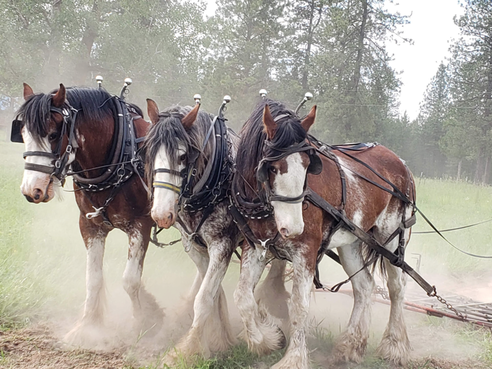Clydesdale Horse Exhibition
 Clydesdale Horses Working a Farm
Clydesdale Horses Working a Farm
The Clydesdale is a breed of heavy draft horse developed in and deriving its name from the district in Scotland where it was founded. Its type was evolved by the farmers of Lanarkshire, through which the River Clyde flows. The old name for Lanarkshire is Clydesdale, where the breed was founded over 200 years ago.
It was bred to meet not only the agricultural needs of these farmers but the demands of commerce for the coal fields of Lanarkshire and all types of heavy haulage on the streets of Glasgow. The breed soon acquired more than a local reputation, and in time, the breed spread throughout the whole of Scotland and northern England.
A Clydesdale foal can weigh 110 to 180 pounds.
A Clydesdale horse may grow as tall as 19 hands, about 6 feet 4 inches, and weigh 1,600 to 2,400 pounds. An adult Clydesdale can eat 25 to 50 pounds of hay each day. The Clydesdale geldings that pull the Budweiser wagons must be 18 hands tall and a bay color with four white legs and a white blaze. However, Clydesdales can also be black or sorrel, and many have splashes of white on their hips, sides, and upper legs. The long flowing hair running down their lower leg is called feather. Early on, breeders noticed horses with long silky feather had good joints and remained sound throughout a long working life. Twenty is considered a long life for a Clydesdale.
At its peak in the early twentieth century, Scotland had around 140,000 farm horses plus an unknown number in towns and cities, most of which were Clydesdales. Their number declined when the army conscripted many to serve in the First World War. After the Second World War, fewer and fewer horses were bred for farm work as the more modern tractor became popular. Numbers slowly dwindled until the breed was finally listed as rare during the 1960s. Since then, their numbers have increased in part due to the efforts of breed societies in Scotland, the United States, Canada, and Australia. Today, over 600 foals are registered each year in the United States.
At Morning View Farm, all the farm work is done with horses; no tractors exist. The farm is in Clayton, WA, about 30 miles north of Spokane. Their busiest season is summer when you can see the Clydesdales mowing, raking, and baling hay most days of the week. The horses skid firewood, plow snow, and till the soil during other seasons.
It was bred to meet not only the agricultural needs of these farmers but the demands of commerce for the coal fields of Lanarkshire and all types of heavy haulage on the streets of Glasgow. The breed soon acquired more than a local reputation, and in time, the breed spread throughout the whole of Scotland and northern England.
A Clydesdale foal can weigh 110 to 180 pounds.
A Clydesdale horse may grow as tall as 19 hands, about 6 feet 4 inches, and weigh 1,600 to 2,400 pounds. An adult Clydesdale can eat 25 to 50 pounds of hay each day. The Clydesdale geldings that pull the Budweiser wagons must be 18 hands tall and a bay color with four white legs and a white blaze. However, Clydesdales can also be black or sorrel, and many have splashes of white on their hips, sides, and upper legs. The long flowing hair running down their lower leg is called feather. Early on, breeders noticed horses with long silky feather had good joints and remained sound throughout a long working life. Twenty is considered a long life for a Clydesdale.
At its peak in the early twentieth century, Scotland had around 140,000 farm horses plus an unknown number in towns and cities, most of which were Clydesdales. Their number declined when the army conscripted many to serve in the First World War. After the Second World War, fewer and fewer horses were bred for farm work as the more modern tractor became popular. Numbers slowly dwindled until the breed was finally listed as rare during the 1960s. Since then, their numbers have increased in part due to the efforts of breed societies in Scotland, the United States, Canada, and Australia. Today, over 600 foals are registered each year in the United States.
At Morning View Farm, all the farm work is done with horses; no tractors exist. The farm is in Clayton, WA, about 30 miles north of Spokane. Their busiest season is summer when you can see the Clydesdales mowing, raking, and baling hay most days of the week. The horses skid firewood, plow snow, and till the soil during other seasons.
